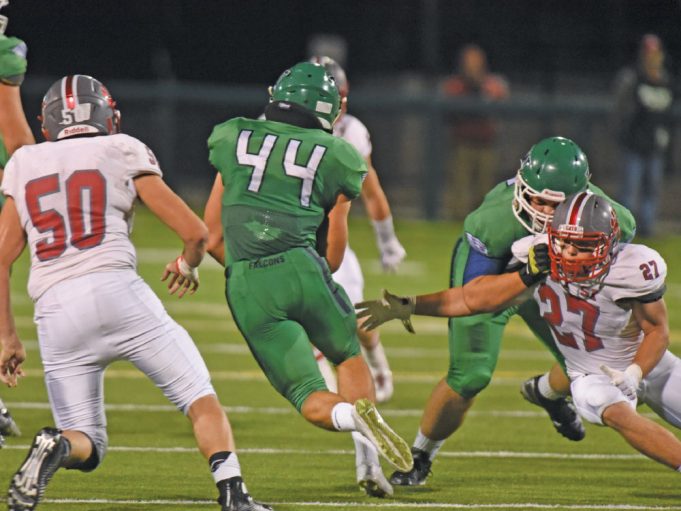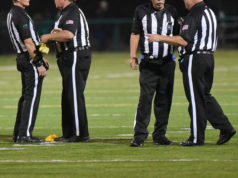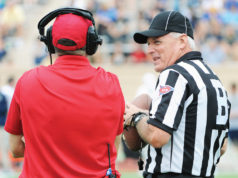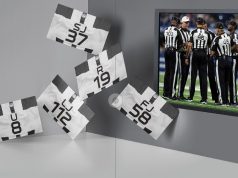The idea of a flag being waved off brings to mind an overbearing referee trumping the decision of a younger crewmate. That has happened on occasion, but picking up a flag can be a prescribed mechanic and it can also be smart officiating. That’s not to say picking up a flag should be done very often, and it certainly is not a crutch to compensate for weak officials. The risks entail antagonizing a thin-skinned official and raising the ire of a coach who thought he had a decision in his favor. The important thing is to get the call right. In addition to picking up a flag, getting it right may entail throwing a late flag or simply having a brief crew discussion that affirms the original call.
For ease of discussion, the scenarios in which picking up a flag may be prudent are grouped in categories based on the circumstances that may dictate the wave-off. The first group is situations where covering officials are not expected to observe events outside their coverage area.
Ineligible receiver downfield/offensive pass interference. Whether an ineligible simply goes downfield or goes downfield beyond the expanded neutral zone (NFHS) or more than three yards (NCAA) and initiates a block against an opponent, a flag should be thrown when a forward pass is thrown and there is a possibility the ball crossed the neutral zone. If it is subsequently determined the pass did not cross the line, the flag must be picked up. Under NFHS rules, a pass deflected by a team B player behind the line is considered to not have crossed the line while in NCAA play that applies for a tip by any player. Depending on crew size, a specific official is responsible for determining if a pass crosses the line, and that probably won’t be the official who observes the possible illegal act.
Defensive pass interference. The flag should be picked up if the pass was tipped prior to the illegal contact. Pass interference restrictions end for all players once a team B player touches the pass. If a team A player tips the ball, restrictions also end for all team B players and for eligible team A players.
Two forward passes. An apparent second forward pass should be flagged and picked up if discussion reveals the first pass was ruled backward.
Illegal participation. When a player is observed returning inbounds (NFHS) or returns inbounds and is the first to touch a pass (NCAA), the flag should be thrown and picked up if discussion reveals the player was blocked out of bounds (in NFHS the player must have returned immediately).
Delay of game. A flag for a delay of game foul can be picked up if another official had granted a timeout before the play clock expired.
The next group includes acts that are highly dependent on the angle of view and almost always have multiple covering officials. Those crewmates must immediately compare notes even if both had flags. In order to change such a call, differing officials must be 100 percent sure of what was observed or they must be able to point out what the calling official did not see. If the two officials cannot agree, the original call should stand.
Targeting. It’s possible to interpret a straight-line view of the engagement as head contact (like an eclipse) when in reality the contact was at or below the shoulders.
Blindside blocks. If open hands are used, the blindside block is legal. The covering official may be screened by the blocker’s back.
Pass interference. There are multiple ways for pass interference to occur and in many cases, no one official can see exactly what transpired, including which player initiated the contact.
Another category includes situations where one official should be able to get the call correct, but for a variety of reasons, including not seeing the whole play, being in a poor position or simply miscounting is unable to do so.
Roughing the kicker. If the referee calls a roughing foul, but the player is blocked into the kicker or the ball is tipped by the contacting player, the contact is excused. Under NCAA rules, the contact is only excused if the block was illegal.
Counting error. If a team is flagged for too many players in the formation and a recount reveals there were only 11 players, the flag must be picked up. Likewise, if a belated count indicates more than 11 players participated, a late flag should be thrown.
Illegal blocks. Officials should not call a foul when they don’t see the whole play. Examples where an official can get a wrong picture of what transpired include blocks in the back where the player abruptly turns on the blocker and blocks below the waist where the initial contact is high and the blocker slides down on the opponent.
The final category includes only one foul. Intentional grounding should only be flagged by the referee and only if it is determined the passer was under duress (the embodiment of intent to conserve yardage).
What's Your Call? Leave a Comment:
Note: This article is archival in nature. Rules, interpretations, mechanics, philosophies and other information may or may not be correct for the current year.
This article is the copyright of ©Referee Enterprises, Inc., and may not be republished in whole or in part online, in print or in any capacity without expressed written permission from Referee. The article is made available for educational use by individuals.


















